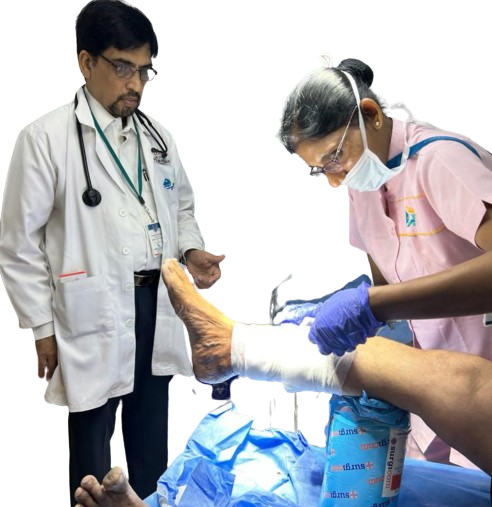Wound Care For Doctors
Wound care is carefully cleansing, disinfecting, and treating wounds in order to facilitate healing and avoid infection for the best possible recovery.
Wound care for doctors:
Wound care for doctors involves a comprehensive approach to managing various types of wounds, including acute injuries, surgical wounds, and chronic wounds. Here’s a general outline of wound care principles for doctors:
- Experienced
- Focused
- High-End Facility
- Pain Regenerative Therapies
- Supportive Team
- Emergency Care
- Special Diagnosis
- Swelling Regenerative Therapies


Evaluate the type, size, and depth of the wound.
Assess the wound bed for signs of infection, necrosis, or foreign bodies.
Consider the patient’s overall health status, comorbidities, and any factors affecting wound healing (e.g., diabetes, vascular disease).
Clean the wound with saline or a mild antiseptic solution to remove debris and bacteria.
Debride necrotic tissue and foreign material to promote wound healing.
Use appropriate techniques for debridement, such as sharp, mechanical, enzymatic, or autolytic debridement, based on wound characteristics.
Assess for signs of infection (e.g., erythema, warmth, purulent drainage).
Consider obtaining wound cultures if infection is suspected.
Prescribe antibiotics if indicated based on clinical judgment and culture results.
Determine the appropriate method of wound closure (primary closure, delayed closure, secondary intention) based on wound characteristics and timing of presentation.
Perform wound closure techniques such as suturing, stapling, or adhesive closure with consideration of cosmetic outcome and functional integrity.
Choose appropriate dressings based on wound type, exudate level, and desired outcomes (e.g., moisture balance, promotion of granulation tissue).
Consider advanced wound care products such as hydrogels, foams, alginates, and silver dressings for specific wound indications.
Educate patients and caregivers on proper wound care techniques, including dressing changes, signs of infection, and when to seek medical attention.
Emphasize the importance of compliance with treatment recommendations to optimize wound healing outcomes.
Schedule follow-up appointments to assess wound progress, monitor for complications, and adjust treatment as needed.
Document wound assessment findings, interventions, and patient education in medical records for continuity of care. This should include serial photography to assess the progress of the wound.
Consider involving interdisciplinary team members such as wound care nurses, physical therapists, and specialists (e.g., infectious disease, vascular surgery) for complex wound management cases.
Collaborate with other healthcare providers to address underlying medical conditions contributing to impaired wound healing.
By following these principles, doctors can effectively manage a wide range of wounds and promote optimal healing outcomes for their patients.
Note: In summary, plastic surgeons play a crucial role in the multidisciplinary approach to wound care, especially when intricate reconstruction and aesthetic considerations are essential for optimal outcomes. Their expertise is valuable in restoring both form and function, and their involvement is often critical in cases of complex wounds and injuries.
